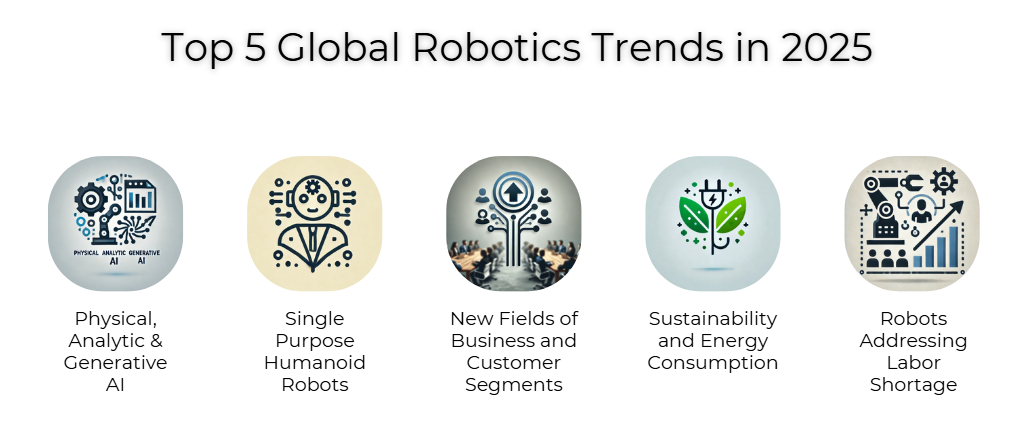
The robotics industry is rapidly evolving, driven by technological advancements and changing market needs. According to the International Federation of Robotics (IFR), five key trends are set to shape the global robotics landscape in 2025. These trends highlight the increasing integration of artificial intelligence, sustainability, and innovative business models. Let's delve into each trend to understand how they will impact industries and society as a whole.

1. Physical, Analytic & Generative AI
Artificial Intelligence continues to be the cornerstone of robotics innovation. In 2025, the focus will be on three distinct areas:
- Physical AI: This refers to robots with enhanced sensory and movement capabilities, enabling them to interact more naturally with the physical world. Expect to see robots that are more agile and capable of performing complex tasks with precision.
- Analytic AI: This involves advanced data processing and predictive analytics, allowing robots to learn from vast amounts of data. Robots will become smarter in decision-making and problem-solving, making them indispensable in industries like healthcare, manufacturing, and logistics.
- Generative AI: This branch of AI enables robots to generate new content, designs, and solutions. It opens up possibilities in creative industries, from designing custom products to developing innovative marketing strategies.
The convergence of these AI technologies will lead to more intelligent and adaptable robots, revolutionizing automation and human-robot collaboration.
2. Single Purpose Humanoids
Humanoid robots have long fascinated the public imagination, but in 2025, they will take on more practical roles. Unlike general-purpose humanoids, Single Purpose Humanoids are designed for specific tasks, enhancing efficiency and productivity. Examples include:
- Customer Service Robots: These humanoids will be optimized for interacting with customers, answering inquiries, and providing personalized assistance in retail and hospitality sectors.
- Healthcare Assistants: Specially designed to assist in caregiving, patient monitoring, and even performing non-invasive medical procedures.
- Logistics and Delivery Robots: These humanoids will navigate complex environments to deliver packages and goods in urban settings.
The specialization of humanoids ensures cost-effective solutions while maintaining a high level of functionality, addressing labor shortages in various industries.
3. Sustainability and Energy Consumption
With growing environmental concerns, the robotics industry is increasingly focusing on sustainability. In 2025, robots will be designed with energy-efficient systems, reducing their carbon footprint. Key trends include:
- Energy-Efficient Actuators: New types of actuators will consume less power while maintaining high performance.
- Recyclable Materials: Robots will be built using eco-friendly and recyclable components, promoting a circular economy.
- Smart Energy Management: Advanced energy management systems will optimize power usage, ensuring longer battery life and reduced energy costs.
These sustainable practices not only benefit the environment but also lower operational costs, making robots more appealing to cost-conscious businesses.
4. New Fields of Business and Customer Segments
Robotics is no longer confined to manufacturing. In 2025, the industry will expand into new markets, unlocking fresh business opportunities. Some emerging fields include:
- Agriculture and Food Production: Robots will enhance productivity through automated planting, harvesting, and food processing.
- Healthcare and Rehabilitation: Advanced medical robots will assist in surgeries, physical therapy, and elderly care.
- Education and Entertainment: Interactive robots will play a crucial role in personalized learning and immersive entertainment experiences.
This expansion will create new revenue streams for robotics companies and provide innovative solutions tailored to diverse customer needs.
5. Robots Addressing Labor Shortage
Labor shortages are a global challenge, impacting productivity and economic growth. In 2025, robots will play a pivotal role in bridging this gap by performing tasks that are labor-intensive, repetitive, or hazardous. Key areas include:
- Manufacturing and Warehousing: Automation will boost productivity by taking over monotonous tasks, reducing human error and fatigue.
- Healthcare and Elderly Care: Robots will support caregivers, offering assistance in mobility, medication management, and companionship for the elderly.
- Service and Hospitality: From cleaning and maintenance to food preparation and delivery, robots will ensure seamless service operations.
By addressing labor shortages, robotics will enhance workforce efficiency and allow human workers to focus on more strategic and creative roles.
Conclusion: The Future is Here
The top 5 global robotics trends in 2025 indicate a transformative shift in how robots are integrated into daily life and business operations. With advancements in AI, specialization in humanoids, emphasis on sustainability, exploration of new markets, and solutions to labor shortages, the robotics industry is poised for unprecedented growth.
For businesses, staying ahead of these trends means gaining a competitive edge by adopting intelligent automation solutions. For consumers, it promises a future where robots enhance quality of life and redefine human potential.
As we move into this new era of robotics, one thing is certain: the future is here, and it's powered by innovation and intelligent automation.
Are You Ready for the Robotics Era?
If you're curious to learn more about how these trends will impact your life and career, stay tuned for my upcoming book, "Are You Ready for the Robotics Era?" It explores the future of robotics and the skills needed to thrive in this rapidly evolving landscape.
Stay informed. Stay ahead. Embrace the future with robotics.
